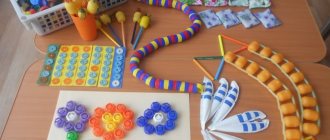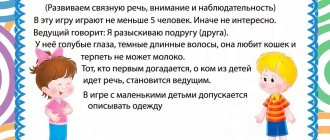Games and exercises for the development of components of the intonation side of speech
And the pots - boom, bang!
Frying pans - don, don!
That's how the dance is - beauty!
Tra-ta-ta, tra-ta-ta!
Games-exercises for the development of tempo organization of statements:
Big feet walked along the road"
Goal: to develop in children the ability to change the tempo of speech in accordance with the tempo of the movement being performed.
Description: According to the speech therapist:
“Big feet walked along the road...”
Children slowly walk in place, raising their legs high and slowly say:
“TOP - TOP.”
Under the words:
"Little feet ran along the path"
children run in place in small steps and quickly say:
“Top - top - top - top.”
Guidelines. In the future, the exercise can be performed to music.
Repeat 3 – 4 times.
"Watch".
Goal: to develop in children the ability to change the tempo of speech in accordance with the tempo of the movement being performed.
Description: Say at different tempos.
Tick tock, tick tock. The clock is big and goes like this.
(They clap and speak slowly.)
Tiki-taki, tiki-taki - The little ones run like that.
(Clap and speak quickly.)
Repeat 3 – 4 times.
"Carousels"
Goal: to develop in children the ability to coordinate speech with movement, gradually changing their tempo.
Description of the game: Children, holding hands, lead a round dance and pronounce words at a slow pace, then start running and pronounce the continuation at a fast pace.
“Barely, barely, barely, barely, the carousel started spinning
(speak at a slow pace)
And then, then, then
(tempo gradually increases)
Everybody run, run, run.
(speak at a fast pace)
Hush, children, don't rush
(tempo gradually slows down)
Stop the carousel
(speak at a slow pace)
One, two, one, two -
(clap your hands and speak slowly)
So the game is over.
Guidelines. The exercise can be performed to music.
Dosage: 2 – 3 times.
"Rain"
Goal: to develop in children the ability to coordinate speech with movement, gradually accelerating their pace.
Game description: Children slowly walk one after another in a circle and slowly say the words:
Drop one, drop two,
The drops barely fall.
Then the pace of movement and speech increases:
And then, then, then-
Everybody run, run, run
.(children run in a circle).
When the words end, the children stop.
We opened our umbrellas
(spread your arms to the sides and join them in a semicircle above your head.)
Sheltered herself from the rain.
Guidelines. The exercise can be performed to music.
Dosage: 3-4 times.
Games and exercises to develop the expressive side of speech
Goal: alternately highlighting words with intonation at the beginning, middle and end of a sentence.
Description: reading tongue twisters should begin at a slow pace, while clearly pronouncing each word. Gradually speed up the pace, but make sure that the child maintains clarity, clarity of pronunciation and maintains the necessary intonation.
Adult voices
There are four main adult parts in the choir, two of them are female, two are male. For women - soprano (high) and alto (low). For men - tenor (high) and bass (low). If a work requires more voices, then each part can be divided into two, three, etc. Then their names are first sopranos, second sopranos.
In solo singing, the divisions are more complicated: shades appear that take into account both the nature of the singing and the range. Soprano is divided into coloratura, lyrical and dramatic (with intermediate shades), mezzo-soprano appears, which is divided into lyrical (high) and dramatic (low). The list could go on for a long time, but let’s return to the main topic - the types of voices in children’s singing.
We conduct lessons ONLINE individually with a teacher. Fill out the form and the administrator will tell you everything.
Sign up
Fighting complexes
For both shy children and introverted adults, singing lessons are useful for liberation. In classes, a person learns to accept his voice and not be afraid of it. Children gain self-confidence and are no longer embarrassed to sing in a vocal ensemble.
Vocal classes are useful for mild speech defects: mild forms of stuttering are treated by singing. If a person experiences pain during a long conversation, his voice gets tired or hissing begins, vocals will help. Staging your voice, breathing, and sound production will relieve tension; people of speaking professions use their voices to facilitate the speaking process.
How to put on a voice at home: tips
Nowadays, with the development of technical capabilities, it is not so difficult to create your own voice. There is a lot of material on this topic on the Internet. Of course, you will have to tinker and study this issue. But with my recommendations, I am sure you will succeed!








